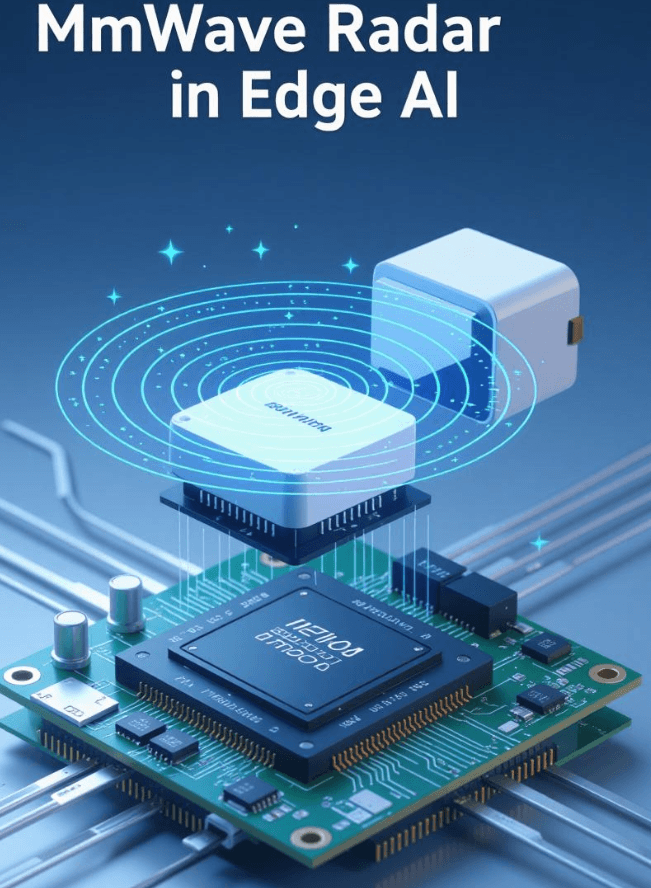Autonomous vehicles "going blind" in heavy fog, industrial robots stalling in dim factory corners, or smart healthcare devices generating false alarms due to lighting changes—these are the critical failures faced by Edge AI systems that rely exclusively on traditional optical sensors (cameras and LiDAR). To achieve true Level 5 autonomy and comprehensive, all-scenario intelligence, machines require a robust perception capability that is unconstrained by the environment.
This is the central, indispensable value proposition of the Millimeter-Wave (mmWave) Radar Sensor.
As NVIDIA’s vice president of robotics and edge AI, Deepu Talla, has emphasized: "We do not build robots, but we enable the whole industry with our infrastructure and software." Platforms like the NVIDIA Jetson AGX Thor Developer Kit are specifically engineered to efficiently process the next generation of high-robustness sensing data that mmWave provides, making real-time autonomous function possible.
This article will delve into how mmWave radar, using its unique physical properties, delivers an all-weather, high-precision, and privacy-preserving perception foundation for critical sectors like autonomous machines, intelligent transportation, and AI-enhanced healthcare. We analyze the specific technical value and the immense potential unlocked through deep integration with powerful Edge AI processors.
The Physics Principle That Breaks Optical Limits
To grasp the full value of mmWave radar, one must start with its operating frequency band.
MmWave radar sensors operate in the 30 GHz to 300 GHz electromagnetic spectrum, with corresponding wavelengths of just 1 to 10 millimeters. Compared to the visible or near-infrared light used by cameras and LiDAR, the longer wavelength characteristic of mmWave grants it an irreplaceable penetration capability:
-
Environmental Penetration: Millimeter waves are able to pass through raindrops, snowflakes, fog, haze, and dust with minimal signal attenuation. This is the fundamental reason optical sensors fail in adverse weather conditions. This physical property ensures a continuous, reliable data stream under virtually any outdoor condition.
-
Material Penetration: MmWave can pass through non-conductive materials like plastic, drywall, and clothing. This enables non-contact vital signs monitoring or stealth deployment, offering unique advantages in medical, security, and smart building applications.
Technical Insight: The Leap from 3D to 4D Point Clouds
Modern mmWave radar primarily utilizes Frequency Modulated Continuous Wave (FMCW) technology. By analyzing the frequency change (Doppler shift) and time delay of the reflected signal, the sensor accurately determines not only a target's range, azimuth, and elevation (3D spatial information), but also its radial velocity, generating a 4D point cloud that includes velocity information.
This 4D data is profoundly valuable to Edge AI systems: AI models can directly leverage the speed information to quickly distinguish between static objects (clutter) and moving targets (e.g., a pedestrian), significantly boosting the accuracy of prediction and tracking algorithms. Furthermore, using Doppler velocity filtering, systems can effectively suppress noise and "ghost targets" caused by multipath reflections, purifying the perception data.
MmWave Radar’s Three Core Values for Edge AI
MmWave radar is essential for multimodal sensor fusion, serving as a critical complement to solve three major perception pain points for AI systems:
1. Achieving All-Weather, All-Environment Robust Perception
In autonomous driving, mmWave radar is arguably the only sensor that maintains high performance in heavy rain, dense fog, or strong backlight. In industrial settings, its ability to penetrate smoke, dust, and metal meshes ensures the safe and continuous operation of industrial robots and Autonomous Mobile Robots (AMRs) in harsh factory environments, dramatically increasing system uptime and reliability.
2. Unique Non-Intrusive Privacy Protection
Crucially, mmWave sensors output abstract 4D point cloud data, not visually identifiable images. This feature allows for continuous monitoring of occupancy, behavior (falls), and vital signs in sensitive environments such as nursing homes or hospitals, while fully adhering to strict privacy regulations (like GDPR).
3. Flexible Deployment via Low Cost and Small Form Factor
Thanks to advanced CMOS single-chip integration technology, high-performance mmWave radar modules are compact and extremely power-efficient (typically consuming around 1W). This small size and low power requirement facilitates large-scale, low-power, and distributed Edge AI sensor network deployment, allowing for easy integration into vehicle bodies or smart city infrastructure.
Overcoming Limitations: The Synergy with NVIDIA Jetson
The main limitation of standard mmWave radar has traditionally been its relatively lower angular resolution compared to high-end LiDAR, making precise differentiation between two extremely close objects a challenge.
The key to solving this challenge lies in the powerful compute capability of Edge AI platforms like the NVIDIA Jetson series:
-
Mitigation of Low Angular Resolution: By deploying complex Deep Learning models (e.g., PointNet++) on the edge, the system can perform super-resolution reconstruction and semantic segmentation on the sparse 4D point cloud data. This allows for precise object classification, differentiating between merged point clusters.
-
Addressing Multipath Interference: The system leverages the parallel processing capabilities of the Jetson's GPU/DLA to execute complex, real-time algorithms like Kalman Filtering and advanced clustering techniques. These methods track multiple targets reliably and suppress "ghost targets" in cluttered environments.
-
High-Bandwidth Data Fusion: The NVIDIA Jetson AGX Thor platform provides the necessary high-speed I/O and unified memory architecture to efficiently fuse the mmWave's precise velocity data with the semantic richness of camera data and the spatial accuracy of LiDAR. This fusion results in high-accuracy, low-latency intelligent decision-making.
This synergy ensures that mmWave radar data is rapidly and accurately converted into machine-understandable, high-semantic intelligence at the edge, a prerequisite for advanced autonomy.
In-Depth Applications of mmWave Radar in Key Industries
1. Intelligent Transportation and Next-Gen Vehicles
In ADAS (Advanced Driver Assistance Systems), 77/79 GHz mmWave radar is a critical sensor for L2+ to L4 functions. It provides long-range detection (up to 200 meters) and superior velocity estimation for systems like Adaptive Cruise Control (ACC), Automatic Emergency Braking (AEB), and Blind Spot Monitoring (BSM), guaranteeing safety under challenging weather conditions.
2. AI-Enhanced Healthcare and Non-Contact Monitoring
60 GHz mmWave radar is transforming healthcare monitoring. It enables continuous, non-contact monitoring of patient heart rate and respiratory rate even through mattresses or blankets. Furthermore, it accurately identifies high-risk behavior like falls or bed-exits. This non-invasive, privacy-preserving approach is revolutionary for elderly care, newborn monitoring, and advanced sleep studies.
3. Industrial and Logistics Robotics (AMR/Cobots)
In factories, warehouses, and logistics centers, mmWave radar is used for AMR obstacle avoidance and precise navigation. It is particularly effective at maintaining stability and reliability in high-density metal shelving environments or areas with significant dust and smoke, ensuring efficient human-robot collaboration.
Conclusion: mmWave Radar, The Perception Bridge to General AI
Millimeter-Wave Radar Sensors are vital, providing the all-weather, high-robustness, and privacy-preserving perception capability essential for the maturity of Edge AI and Robotics. They uniquely compensate for the failures of optical sensors and, through deep fusion with high-performance edge computing platforms like NVIDIA Jetson, transform 4D point cloud data into real-time, highly accurate intelligent decisions.
As 4D imaging radar technology continues to mature and scale, mmWave radar will not just be a complementary sensor but the fundamental building block for constructing future general autonomous systems and high-reliability smart infrastructure.
Frequently Asked Questions (FAQ)
What is 4D Imaging Radar?
4D Imaging Radar is the advanced generation of mmWave radar that simultaneously outputs the target's range, azimuth, elevation (3D space), and radial velocity, generating a high-density point cloud.
How is the issue of low angular resolution addressed in mmWave radar?
It is mitigated through MIMO (Multiple-Input Multiple-Output) antenna arrays in hardware and by deploying deep learning super-resolution algorithms on powerful edge platforms like NVIDIA Jetson.
What is the typical latency of mmWave radar?
Due to its solid-state design and the on-chip integration of DSP/MCU processing, mmWave radar achieves extremely low sensing latency, typically in the millisecond range, which is crucial for real-time decision-making in autonomous systems.
What are the main benefits of mmWave radar over LiDAR?
MmWave radar holds significant advantages in adverse weather penetration, precise target velocity measurement, privacy preservation, and cost-effectiveness for large-scale deployment.



